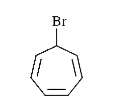Which of the following compounds will produce a precipitate with AgNO3 ?




The correct Answer is:D
To determine which of the given compounds will produce a precipitate with AgNO₃, we need to analyze each compound's ability to form a precipitate with silver nitrate. A precipitate forms when a reaction leads to the formation of an insoluble compound. In this case, we are particularly interested in the formation of silver halides, such as AgBr.
1. Identify the Compounds: We need to analyze the compounds provided in the options. Let's assume the compounds are XBr, YCl, ZI, and W (where W is a different compound).
2. Reactions with AgNO₃:
- For XBr:
- When XBr is reacted with AgNO₃, the reaction will be:
XBr+AgNO3→AgBr+XNO3
- AgBr is a yellow precipitate, indicating that XBr will produce a precipitate with AgNO₃.
- For YCl:
- The reaction will be:
YCl+AgNO3→AgCl+YNO3
- AgCl is a white precipitate, indicating that YCl will also produce a precipitate with AgNO₃.
- For ZI:
- The reaction will be:
ZI+AgNO3→AgI+ZNO3
- AgI is a yellow precipitate, indicating that ZI will also produce a precipitate with AgNO₃.
- For W:
- Depending on the nature of W, we need to analyze if it contains a halide that can react with AgNO₃. If W does not contain a halide, it will not produce a precipitate.
3. Conclusion:
- Based on the analysis, the compounds that will produce a precipitate with AgNO₃ are XBr, YCl, and ZI. The specific compound that produces the most stable precipitate, considering the stability of the resulting ions, is determined by the nature of the positive charge and resonance stability.
Final Answer:
The compounds that will produce a precipitate with AgNO₃ are XBr, YCl, and ZI. The most stable compound among them is the one that shows resonance stabilization.
- For XBr:
- When XBr is reacted with AgNO₃, the reaction will be:
XBr+AgNO3→AgBr+XNO3
- AgBr is a yellow precipitate, indicating that XBr will produce a precipitate with AgNO₃.
- The reaction will be:
YCl+AgNO3→AgCl+YNO3
- AgCl is a white precipitate, indicating that YCl will also produce a precipitate with AgNO₃.
- The reaction will be:
ZI+AgNO3→AgI+ZNO3
- AgI is a yellow precipitate, indicating that ZI will also produce a precipitate with AgNO₃.
- Depending on the nature of W, we need to analyze if it contains a halide that can react with AgNO₃. If W does not contain a halide, it will not produce a precipitate.
- Based on the analysis, the compounds that will produce a precipitate with AgNO₃ are XBr, YCl, and ZI. The specific compound that produces the most stable precipitate, considering the stability of the resulting ions, is determined by the nature of the positive charge and resonance stability.
The compounds that will produce a precipitate with AgNO₃ are XBr, YCl, and ZI. The most stable compound among them is the one that shows resonance stabilization.
Topper's Solved these Questions
- BOOK - VMC MODULES ENGLISHCHAPTER - JEE MAIN REVISION TEST 5 (2020)EXERCISE - CHEMISTRY (SECTION 2)5videos
JEE MAIN REVISION TEST 5 (2020)
- BOOK - VMC MODULES ENGLISHCHAPTER - JEE MAIN REVISION TEST 11 (2020) EXERCISE - CHEMISTRY (SECTION - 2)5videos
JEE MAIN REVISION TEST 11 (2020)
- BOOK - VMC MODULES ENGLISHCHAPTER - JEE MAIN REVISION TEST 8 (2020)EXERCISE - CHEMISTRY (SECTION 2)5videos
JEE MAIN REVISION TEST 8 (2020)
Similar Questions
Knowledge Check
- Question 1 - Select One or More
Which of the following compounds will not produce CO2 on reaction with NaHCO3 ?
A B
B C
C D
D
Which of the following compounds will give curdy precipate with AgNO3 solution?
View SolutionWhich of the following will not produce a precipitate with AgNO3 solution?
View SolutionWhich of the following compounds will give a yellow precipitate with iodine alkali?
View SolutionWhich one of the following is likely to give a precipitate with AgNO3 solution ?
View SolutionWhich one of the following is likely to give a precipitate with AgNO3 solution ?
View SolutionWhich of the following compound will give a yellow precipitate with iodine and alkali?
View SolutionWhich of the following does not give a precipitate with alcoholic AgNO3 ?
View Solution
